Quote of the Week:
"Things can only get better."
Divorced From Fundamentals...
We’d like to take a moment and just reflect back on what’s happened over the past few weeks. Global pandemic hits; the world shuts down; investors panic because they fear companies are going to go bust. But then central banks and governments step in; financial panic is averted; stock markets make their way towards pre- pandemic highs.
The first leg of this was led by secular winners, and we have detailed before the narrowing in breadth this created. But in the last few days, the rotation has swept up the laggards - retailers, airline companies, even a car rental company that has declared bankruptcy have seen sharp recoveries in their share prices.
Indeed, the Russell Microcaps Index – an index of about 1,000 stocks with an average market cap of USD240 million – is less than 10% away from its all-time high (Portfolio A, Figure 2), despite the average stock having a debt-to-enterprise value (‘EV’) ratio of 65%. (For comparison, the average debt-to-EV ratio for the S&P500 Index is about 30%).
Separately, we constructed an equal-weighted portfolio of all the listed US companies with a credit default swap of more than 1,000 basis points as of 1 April, 2020. This portfolio has outperformed the MSCI US Index month-to- date, even after huge retracements as the US market fell sharply last week (Portfolio A, Figure 2). Speculative excesses such as this do give us some pause about the durability of the recovery. There are some movements in price which seem entirely divorced from fundamentals.
Figure 1. Russell Microcaps Index
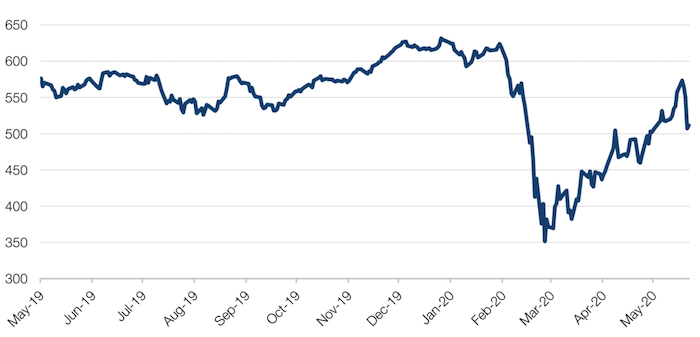
Source: Bloomberg; as of 12 June 2020.
Figure 2. MSCI USA Versus Portfolio A
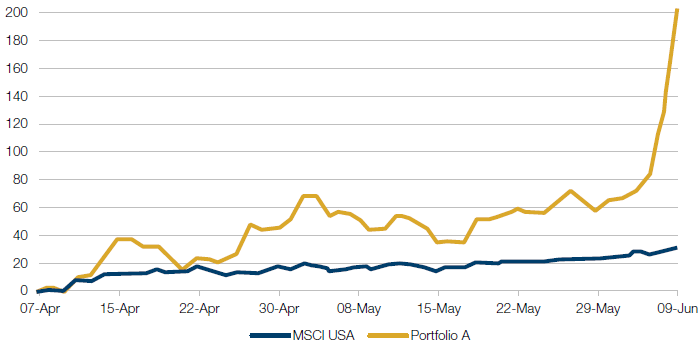
Source: Bloomberg; as of 9 June 2020. Portfolio results should be considered hypothetical. Please see the end of this paper for additional important information on hypothetical results.
Cross-Asset Volatility: Not Out of the Woods Yet
The coronacrisis saw volatility spike across asset classes before climbing back down in response to the Federal Reserve’s ‘bazooka’ intervention – comprising some USD2.3 trillion.
However, this uniform decrease in volatility may not hold.
We have seen a small tick up in bond vol (Figure 3). This is not something that is overly concerning to us, given the willingness of the Fed to offer liquidity and to engage in bond purchasing.
But bond volatility is much easier to control than FX volatility (Figure 4). A bond selloff can be partly controlled by one central bank offering liquidity (to prevent companies going bankrupt and ensure they keep paying their debt obligations) and buying bonds (to ensure there is actually a bid in the market). For FX volatility to be kept low, it requires multiple central banks and governments to act in a concerted fashion, introducing policy initiatives in lockstep. This is feasible during a crisis: almost all central banks in the developed world cut rates and re-started quantitative easing as soon as the coronacrisis occurred. It becomes rather less likely when we consider big fiscal policy moves are almost inevitable as countries seek a route out of the crisis. FX volatility is now closer to its 10-year lows than ten-year highs, which seems to assume similar policy trajectories for vastly different geographies. To assume FX vol stays at current levels is, in our view, a remarkably optimistic outlook and leaves room for big shocks.
Indeed, anything that looks ‘risky’ still hasn’t come down anywhere as near as FX or bond markets (Figure 5). This includes gold vol, which despite its relationship with the US dollar, has speculative demand for calls as a hedge to market risk and/or inflation and, thus, remains relatively high.
Figure 3. Bond Volatility – MOVE Index
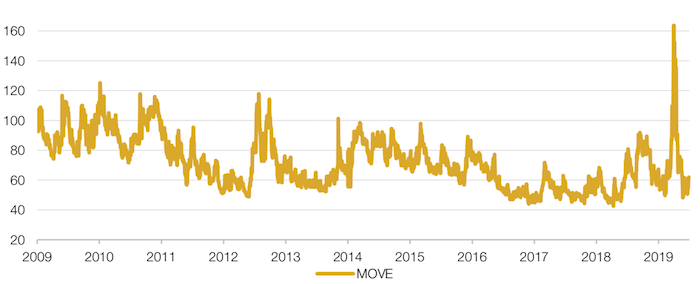
Source: Bloomberg; as of 9 June 2020.
Figure 4. Euro and Japanese Yen Volatility
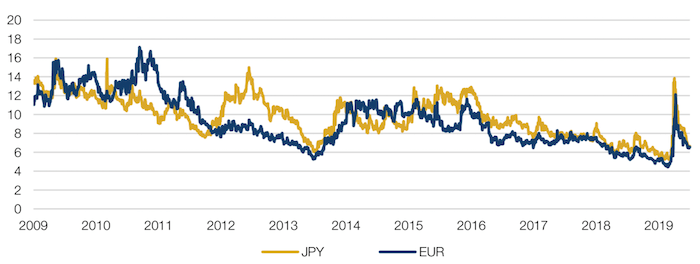
Source: Bloomberg; as of 9 June 2020.
Figure 5. Cross-Asset Volatility
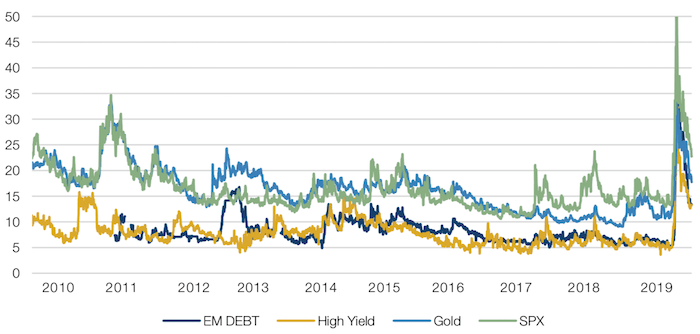
Source: Bloomberg; as of 9 June 2020.
What’s the Yield Curve Telling Us Now?
The 10-2 yield curve has crossed the 200-week moving average, only the fourth time it has done so in 20 years (depicted by the circles in Figure 6). In each of the four cases, the circle occurs at or just slightly preceding a recession. All the circles represent bull steepeners, except for 2013, which was a bear steepener.
What has this move historically told us about returns in different asset classes and styles? We make four observations:
- The MSCI World makes consistent losses, except during the bear steepener. This intuitively makes sense, because you are heading into a recession;
- Value does consistently well. This is a little bit surprising to us since the sectors that typically make up Value don’t do well during recessionary periods. An acute observer could say that the returns could be skewed by the dotcom crash, where Growth cratered and Value outperformed. However, even without skew of dotcom returns, Value outperforms;
- Commodities are weak;
- The economy does poorly and consistent with that, bonds rally.
Of course, the current crisis is unlike any before, and it could be the case that such a sharp endogenous shock will be absorbed quickly as economies continue to normalise. However, there is a real possibility that this may not be the case: as furlough schemes end, and if corporates go out of business, we could see a second spike in unemployment as a consequence. If unemployment does tick up again, it’s a reasonable indicator of more troubles ahead, which has also been signalled by the yield curve.
Figure 6. 10-2 Yield Curve
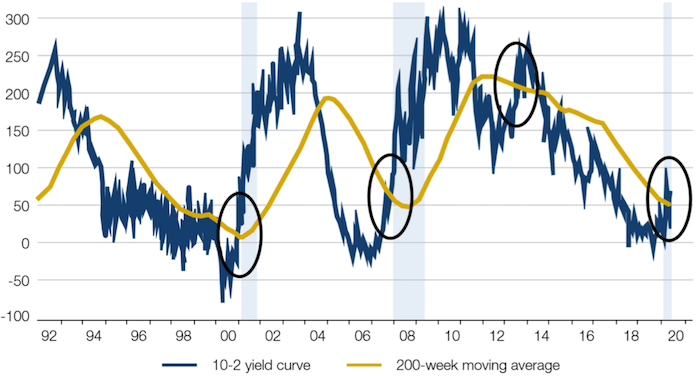
Source: Bloomberg; as of 9 June 2020.
With contribution from: Ed Cole (Man GLG, Managing Director – Equities) and Peter van Dooijeweert (Man Solutions, Head of Institutional Hedging).
You are now leaving Man Group’s website
You are leaving Man Group’s website and entering a third-party website that is not controlled, maintained, or monitored by Man Group. Man Group is not responsible for the content or availability of the third-party website. By leaving Man Group’s website, you will be subject to the third-party website’s terms, policies and/or notices, including those related to privacy and security, as applicable.